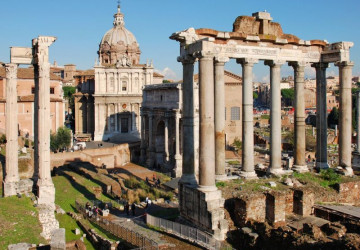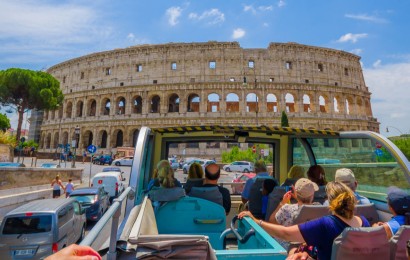In the heart of Rome, between the Colosseum and Piazza Venezia, lies one of the most fascinating archaeological sites in the world — the Roman Forum. Walking through its ruins means travelling across centuries of history, breathing in the grandeur of ancient Rome, and discovering how urban planning became both a political and symbolic language. From Julius Caesar to Trajan, the Forum represented not only the political and economic heart of the Empire but also an architectural manifesto of Roman greatness.
In this article, we’ll explore how the Roman Forum was created, what role it played in imperial Rome, the differences between its various sections, and why it remains one of the most unmissable experiences for anyone visiting Rome.
What Is the Roman Forum
The term “Roman Forum” today commonly refers to the entire archaeological area stretching between the Colosseum and Piazza Venezia — an extraordinary complex of monumental squares and temples built by the great emperors of Rome: Caesar, Augustus, Vespasian, Nerva, and Trajan.
Originally, the Forum Romanum was the civic, political, and religious center of the Republic. As the Empire expanded, it became too small to host all public and administrative activities. The emperors therefore created a series of new monumental spaces — what we now call the Imperial Forums — that extended the original Forum and celebrated the divine authority of the ruler.
Today, the Roman Forum includes all these layers of history and can be visited as one vast open-air museum.
The Story of the Roman Forum
The Forum of Caesar: The Birth of a New Urban Model
The first of the Imperial extensions was the Forum of Caesar, inaugurated in 46 BC by Gaius Julius Caesar.
At the time, the old Republican Forum was already overcrowded with public buildings and daily business. Caesar decided to build a new, orderly, and functional space that reflected both his authority and his continuity with Republican traditions.
The complex had a rectangular layout with a grand equestrian statue of Caesar at its center, surrounded by porticoes and shops. At the far end stood the Temple of Venus Genetrix, the goddess from whom Caesar claimed descent.
This project marked the beginning of a new era in Roman urbanism: from that moment on, every emperor would build his own forum as a symbol of power and divine legitimacy.
The Forum of Augustus: The Empire Finds Its Form
After Caesar, Augustus — his successor and the first emperor of Rome — built a new forum dedicated to Mars Ultor, the god of vengeance and justice.
The Forum of Augustus, inaugurated in 2 BC, was meant to celebrate his victory over Brutus and Cassius, Caesar’s assassins, and to symbolize the peace and order restored after years of civil war.
The complex was enclosed by a high peperino and travertine wall, isolating it from the surrounding neighborhoods and giving it an aura of sacredness. At its center stood the Temple of Mars Ultor, richly decorated with marbles and statues of heroes such as Aeneas, Romulus, and Augustus himself.
It became the symbolic place of imperial justice, where generals received their commands before leaving for military campaigns and where the Senate met to discuss foreign policy.
The Forum of Peace (Vespasian’s Forum): A Celebration of Victory
After the great fire of 64 AD, Vespasian, founder of the Flavian dynasty, built a new forum to celebrate the peace restored after the Jewish War.
The Forum of Peace, inaugurated in 75 AD, was conceived as a vast open area with gardens, porticoes, and the Temple of Peace at its center.
Inside were the famous marble cadastral maps of Rome (Forma Urbis Romae) and numerous works of art brought back from military campaigns, including treasures from the Temple of Jerusalem.
More than a political center, this forum served a symbolic and cultural function, representing the end of war and the beginning of a new age of prosperity.
The Forum of Nerva: The Transitional Forum
Built between 80 and 97 AD, the Forum of Nerva — also known as the Transitory Forum — connected the other imperial fora.
Construction began under Domitian and was completed by Nerva, who gave it his name.
Because of limited space, the Forum of Nerva had an elongated, theatrical shape: a monumental corridor lined with tall colonnades and dominated by the Temple of Minerva, the emperor’s patron goddess.
Its walls were adorned with reliefs of allegorical female figures representing the provinces of the Empire, symbolizing Rome’s power and its ability to unite diverse peoples under one rule.
The Forum of Trajan: The Peak of Imperial Architecture
The final and most magnificent addition to the Roman Forum was the Forum of Trajan, inaugurated in 112 AD after the emperor’s victory over the Dacians (modern-day Romania).
The project, designed by Apollodorus of Damascus, was unlike anything built before: a vast square surrounded by porticoes, an enormous basilica, and the iconic Trajan’s Column.
Standing nearly 30 meters tall, the column’s spiral frieze narrates the emperor’s Dacian campaigns in exquisite detail. It was not only a celebratory monument but also Trajan’s tomb, as his ashes were placed within its base.
Behind the main piazza stood the Basilica Ulpia, the administrative heart of the complex, and the Markets of Trajan, a multi-level brick structure often considered the world’s first shopping center.
The Forum of Trajan represents the height of Roman urban planning — a perfect synthesis of functionality, propaganda, and monumental art.
What Was the Roman Forum Used For?
The Roman Forum was not just a collection of plazas — it was the beating heart of imperial power, designed to display the grandeur of the emperor and the Empire.
Across its temples, basilicas, and public spaces took place:
- Religious ceremonies dedicated to the gods protecting the emperor.
- Official processions and celebrations marking military victories.
- Judicial proceedings inside the basilicas.
- Political discussions within the Senate and public assemblies.
Every architectural detail — from columns to statues — carried a message of divine continuity, linking the emperor’s authority to the gods themselves.
Where the Roman Forum Is and How to Visit It
The Roman Forum stretches between Via dei Fori Imperiali and Via Alessandrina, in the very center of Rome, within walking distance of both the Colosseum and Piazza Venezia.
Visitors can explore the area through various guided tours, which bring history to life with 3D reconstructions, night experiences, and professional guides who reveal the stories behind the ruins.
Today, the Roman Forum walking route connects Caesar’s and Trajan’s sections, offering a complete view of how the site evolved over the centuries.
Book a guided tour of the Colosseum and Roman Forum with Green Line Tours and relive the history of ancient Rome where emperors shaped the destiny of the world’s greatest empire.

